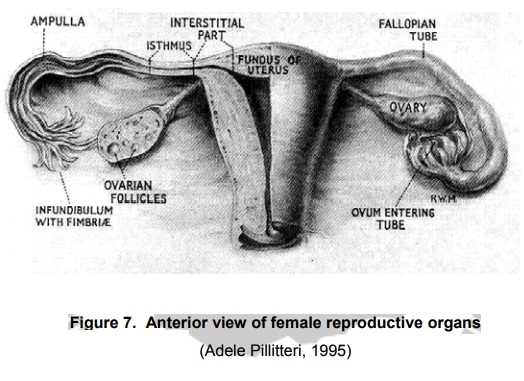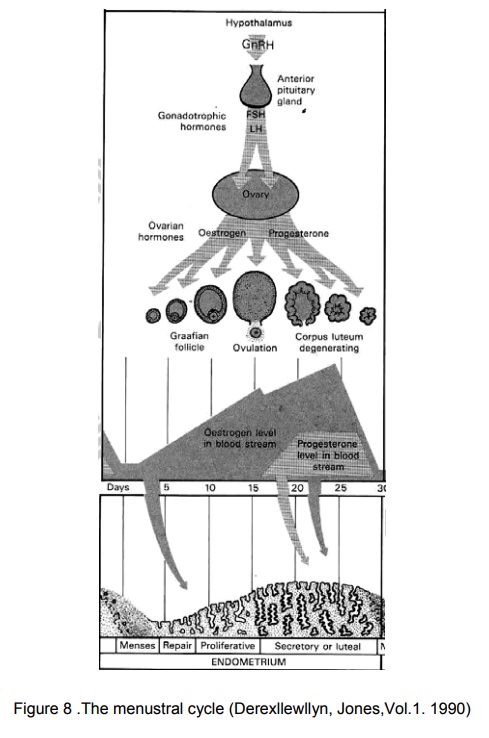Chapter: Obstetric and Gynecological Nursing : Anatomy of Female Pelvis and the Fetal Skull
Physiology of the Female Reproductive Organs

Physiology of the Femel
Reproductive Organs
1. Puberty - the age of sexual maturation
ThIs is the stage of life at which secondary sexual characterstics
appear. Girls begin dramatic development and maturation of reproductive organs
at approximately age 12 to 13 years, Although the mechanism that initiates this
dramatic change is not well understood, the hypothalamus under the direction of
the centeral nerveous system may initiate or regulate mechanism set to “turn
on” gonadal functioning at this age.
There is a wide variation in the times that adolescents move through
developmental stages; however the sequential order is fairly constant. In girls
pubertal changes typically occur in the order of:
·
Marked physical growth
·
Increase in the transvers diameter of the pelvis
·
Breast development
·
Growth of pubic and axillary hair
·
Vaginal secretion /Menarche
2. The menstrual cycle
A menstrual cycle (also termed a female reproductive cycle) can be
defined as periodic uterine bleeding in response to cyclic hormonal changes or
a serioes of changes that occur on the ovary, uterus, and cervix in response to
hormonal change. The average age at which menarche (the first menustral period)
occurs at the average age of 12.8 years. This may occur as early as age 9 or as
late as age 17 years.
The purpose of a menstrual cycle is to bring an ovum to maturity and
renew a uterine tissue bed that will be responsive to its growth should it be
fertilized.
The average age of onset of menstrual cycles is 21 to 35 days.The
accepted average length is 28 days.The length of the average menstrual flow is
1-9 days and the average length is 5 days.Amount of flow is from spotting to 80
ml on average.
Four body structures that are involved in the normal physiology of the
menstrual cycle are:
·
The hypothalamus
·
The pituitary gland
·
The ovaries and
·
The uterus.
·
Cervix
For a menstrual cycle to be complete, all four structures must
contribute their part, in activity from any part will result in an incomplete
or ineffective cycle.
Some women have symptoms of anxiety, fatigue, abdominal bloating,
headache, appetite disturbance, irritability and depression in pre-manustural
period. Some women may experience abdominal pain during ovulation and the
release of accompanying prostaglandins. Some even notice irritation when a drop
or two of follicular fiuid or blood spills in to the abdominal cavity.Thispain,
called mitlelschmerz may range from a few sharp cramps to several hours of
discomfort. It is typically felt on either side of the abdomen (near an ovary)
and may be accompanied by scant vaginal spotting.It is known as Mittelschmerz.
3. Phases of menstrual cycle
Proliterative phase: - Immediately following a
menstrual flow(occurring the first 4 or 5 days of a cycle), the endometrium, or
lining of the uterus is very thin, only approximately one cell layer in depth.
As the ovary begins to form estrogen (in the funicular fluid, under the
direction of the pituitary FSH), the endometrium begins to proliferate, or grow
very rapidly, increasing in thickness approximately eight fold. This increase
continues for the first half of the menstrual cycle (from approximately day 5
to day 14). This half of a menstrual cycle is termed interchangeably as the
proliferative, estrogenic, follicular, or postmenstrual phase.
Secratory phase- What occurs in the next half
of in amenstrual cycle depends on whether the released ovum meets and is
fertilized by spermatozoa.
If fertilization does not occur, the corpus luteum in the ovary begins
to regress after 8 to 10 days. As it regresses, the production of progesterone
and oestrogen decreases. With the withdrawal of progesterone stimulation, the
endometrium of the uterus begins to degenerate (at approximately day 24 or day
25 of the cycle). The capillaries rupture, with minute hemorrhage, the
endometrium sloughs off, and menustration starts.

Related Topics